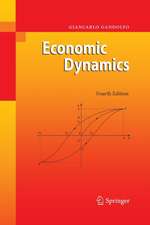Agent-Based Computer Simulation of Dichotomous Economic Growth: Advances in Computational Economics, cartea 13
Autor Roger A. McCainen Limba Engleză Paperback – 4 oct 2012
The study is an exercise in comparative simulation. That is, the same family of growth models will be simulated under different assumptions about the nature of the learning process and details of the production and growth processes. The purpose of this procedure is to establish a relationship between the assumptions and the simulation results.
The study brings together a number of theoretical and technical developments, only some of which may be familiar to any particular reader. In this first chapter, some issues in economic growth are reviewed and the objectives of the study are outlined. In the second chapter, the simulation techniques are introduced and illustrated with baseline simulations of boundedly rational learning processes that do not involve the complications of dealing with long-run economic growth. The third chapter sketches the consensus modern theory of economic growth which is the starting point for further study. In the fourth chapter, a family of steady growth models are simulated, bringing the simulation, growth and learning aspects of the study together. In subsequent chapters, variants on the growth model are explored in a similar way. The ninth chapter introduces trade, with a spacial trading model that is combined with the growth model in the tenth chapter.
The book returns again and again to the key question: to what extent can the simulations `explain' the puzzles of economic growth, and particularly the key puzzle of dichotomization, by constructing growth and learning processes that produce the puzzling results? And just what assumptions of the simulations are most predictable associated with the puzzling results?
| Toate formatele și edițiile | Preț | Express |
|---|---|---|
| Paperback (1) | 938.83 lei 43-57 zile | |
| Springer Us – 4 oct 2012 | 938.83 lei 43-57 zile | |
| Hardback (1) | 944.82 lei 43-57 zile | |
| Springer Us – 30 noi 1999 | 944.82 lei 43-57 zile |
Din seria Advances in Computational Economics
-
 Preț: 391.40 lei
Preț: 391.40 lei - 18%
 Preț: 1822.57 lei
Preț: 1822.57 lei - 18%
 Preț: 1228.15 lei
Preț: 1228.15 lei - 18%
 Preț: 951.47 lei
Preț: 951.47 lei - 18%
 Preț: 944.82 lei
Preț: 944.82 lei - 18%
 Preț: 945.92 lei
Preț: 945.92 lei - 15%
 Preț: 635.80 lei
Preț: 635.80 lei - 15%
 Preț: 644.49 lei
Preț: 644.49 lei - 18%
 Preț: 954.14 lei
Preț: 954.14 lei - 18%
 Preț: 963.77 lei
Preț: 963.77 lei - 15%
 Preț: 646.94 lei
Preț: 646.94 lei - 15%
 Preț: 644.30 lei
Preț: 644.30 lei - 18%
 Preț: 954.62 lei
Preț: 954.62 lei - 5%
 Preț: 651.34 lei
Preț: 651.34 lei - 15%
 Preț: 644.49 lei
Preț: 644.49 lei - 18%
 Preț: 948.29 lei
Preț: 948.29 lei - 15%
 Preț: 646.62 lei
Preț: 646.62 lei - 18%
 Preț: 955.08 lei
Preț: 955.08 lei - 15%
 Preț: 640.88 lei
Preț: 640.88 lei - 18%
 Preț: 1223.88 lei
Preț: 1223.88 lei - 18%
 Preț: 953.35 lei
Preț: 953.35 lei
Preț: 938.83 lei
Preț vechi: 1144.91 lei
-18% Nou
Puncte Express: 1408
Preț estimativ în valută:
179.65€ • 188.04$ • 149.52£
179.65€ • 188.04$ • 149.52£
Carte tipărită la comandă
Livrare economică 31 martie-14 aprilie
Preluare comenzi: 021 569.72.76
Specificații
ISBN-13: 9781461370857
ISBN-10: 146137085X
Pagini: 176
Ilustrații: IX, 163 p.
Dimensiuni: 155 x 235 x 9 mm
Greutate: 0.25 kg
Ediția:Softcover reprint of the original 1st ed. 2000
Editura: Springer Us
Colecția Springer
Seria Advances in Computational Economics
Locul publicării:New York, NY, United States
ISBN-10: 146137085X
Pagini: 176
Ilustrații: IX, 163 p.
Dimensiuni: 155 x 235 x 9 mm
Greutate: 0.25 kg
Ediția:Softcover reprint of the original 1st ed. 2000
Editura: Springer Us
Colecția Springer
Seria Advances in Computational Economics
Locul publicării:New York, NY, United States
Public țintă
ResearchCuprins
1 Introduction.- 2 Dichotomization Without Steady Growth: Baseline Simulations.- Figures for Chapter 2.- 3 Steady Economic Growth: The Cobb-Douglas Case with “Engineering- School” Human Capital.- Figures for Chapter 3.- 4 Simulations of Steady Economic Growth With a Cobb-Douglas Production Function.- Figures for Chapter 4.- 5 Growth with Non-Unitary Elasticities of Substitution.- Figures for Chapter 5.- 6 Learning-By-Doing and the Puzzles of Economic Growth: Survey and Interpretation.- Figure for Chapter 6.- 7 Learning by Doing and Dichotomous Development.- Figures for Chapter 7.- 8 Simulations with Irregular Neighborhoods.- Figures for Chapter 8.- 9 Boolean Trade Networks.- Figures for Chapter 9.- 10 Backwash and Spread: Trade Networks in A Space of Agents Who Learn by Doing.- Figures for Chapter 10.- 11 Concluding Summary.- References.- Appendix: Program Code.












